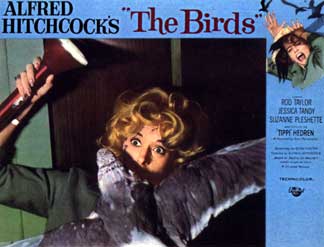
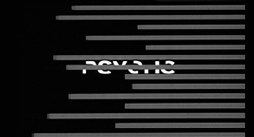
Film Analysis Psycho
Key film vocabulary word: “Voyeurism”- the act of watching somebody without them knowing they’re being watched. As movie viewers we are voyeurs, especially when Subjective Camera Angle is used (POV shot), putting us into the place of the subject, seeing through their eyes, from their perspective.
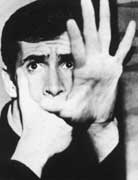
Main
themes:
Splitting/Duality-
all characters are in conflict with themselves;
everyone has a secret:
Sam & Marion – their affair
Sam- hides Marion/his lover
Marion- hides money/crime/identity
Caroline (secretary)- hides tranquilizers from husband
Lowery (boss)- hides whiskey in desk
Cassidy (client)- hides money from IRS
Norman- hides mother and mother’s death and murders/bodies
Examples
of how we SEE this theme of dual natures/contrasts:
White gleaming bathroom with the dirty swamp, both sites for Marion’s body. Audiences don’t expect bathrooms to be a scene of murder. She goes from the bathroom, where she is scrubbing herself clean after deciding to return the money (washing herself of her sin), to being dumped in the dirty swamp after being murdered- there is no going back, or redemption, for her... Norman saw to that. (Trivia: it was the first film to show a toilet flushing.)
City (Phoenix) with country/small town. Cities being the site of sin and decadence, small towns being somehow more innocent and wholesome.
From day (clarity of vision, lightness) to night (marred vision, darkness).
The Title sequence shows words being split, lines bisecting lines.
The driving scene when Marion imagines people reacting to her disappearance cuts from her worried face to her POV shot driving. As the night gets darker, the music gets more anxious, along with her facial expressions, screeching more crazily. (Bernard Herrman, the composer, used only string instruments for this bird-like abrasive sound.)
As she's driving and hearing the voices in her head,
as we do, the rain starts and then gets heavier and heavier until she
can’t see and is forced (by fate?) to pull off the road. The first
thing she sees with any clarity is the neon Bates Motel sign, a signaling
for her entrance into Norman’s nightmare world; it marks the transition
from the first part of the film being about her, to the second part being
about Norman. It is a twisted version of a lighthouse inviting you in
from the storm.
Mirrors show doubles of
people and act as a source of self-reflection, as in the motel lobby scene
with Marion and Norman, in which we see Marion as a double, clutching
her purse with the stolen money.
Sam and Norman mirror each other in the motel lobby while Lila inspects
Marions’s motel room, one in black, one in white.
The horizontal composition of the motel split
by the vertical direction of the dreaded house on hill cutting it in two.
This house has become iconic, perched as it is, into our collective film
consciousness.
Knife cuts Marion’s body, with the
music screeching as the knife stabs.
"The Parlor Scene In Psycho: Images of Duality by Michael Schmidt:
http://www.imagesjournal.com/issue02/features/psycho.htm
Voyeurism/Looking/Watching-
The camera as an extension of the eye of
the viewer- Subjective Camera Angles.
Norman and the movie viewer are Peeping Toms, what we see is partial and
illusory because of it. That vision is imperfect
and an incomplete source of knowledge is a common Hitchcock theme;
he delights in letting his audience know that he is playing with them,
that it is a construct. He is telling us that we can’t rely on our
sense of sight for truth/knowledge, therefore how people appear is not
necessarily how they really are within- appearances can be deceiving,
just as they can be used to tell you a story, to make you ask certain
questions.
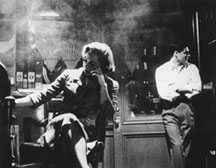
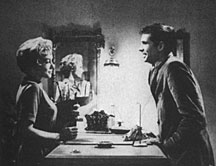
Have students make lists from the following discussions in their journals:
Elements
of Horror film:
old house on hill
dark stormy night
gruesome murder
missing money, person, body
secrets
corpse
How there birds
are used throughout the film:
The stuffed birds in the motel’s lounge where Norman and Marion chat; they cast nasty shadows, with wings outstretched. In one shot the wings line up so they seem to sprout from his head, as he talks about being trapped: “We scratch and we claw”, says Norman.
High-angled shots, as if from “birds’-eye”
view.
Screeching music.
Norman-as-bird in shots, eating Kandy Korn.
Norman shot to make him look birdlike: from underneath, as he turn and lifts his chin up, as in the scene in which Arbogast is in the motel lobby asking about Marion.
Phoenix as a location and Crane as name.
Birds can be seen as passive viewers, like a movie audience is.
The paintings of Birds in Marion’s motel room.
How stereotypes
are challenged and condoned:
Stereotypical ideas of women and men are portrayed, which is an opportunity to talk about what “gender” is, how it can be constructed by what we see over and over in the media, how something becomes a stereotype.
The idea of the “Icebox Blonde”, a woman
on display, being watched. Does Marion get killed (punished?) because
she lives a life outside of the stereotype: she is single and independent,
she is having sex outside of marriage.
The idea of women wanting marriage and a man in order to be happy and
complete.
The idea that men are expected to be big and strong- the way his “mother”
insults Norman emasculated him: does Norman go psycho because of this
pressure to be a man?
Other
stereotypes:
The idea of “the American
Dream”, and how it turns into a nightmare.
Hitchcock would purposely put things into the script that he knew would
be censored so that the things he really wanted, like the shower scene,
would pass by, pale in comparison. Having a man and woman on a bed together,
let alone in her slip, was risqué in 1960, as was showing a toilet,
let alone watching it flush. (Students love having this sort of historical
perspective.)
The idea of a quaint small town, as seen in the characters
of Sheriff Chambers and his wife, the idea being that nothing so abhorrent
could occur there, that this ideal is a fiction. The scene in front of
the church is a great example of Hitchcock’s sense of humour:
Mrs.Chambers to Sam and Lila regarding the missing
Marion:
“It’s Sunday. Come on over to the house and do your reporting
around dinner time. It’ll make it nicer.”
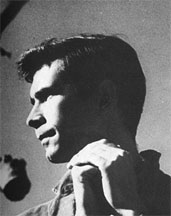
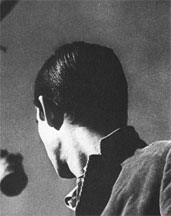
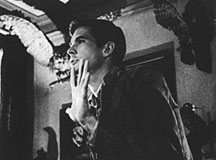
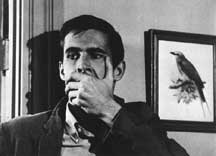
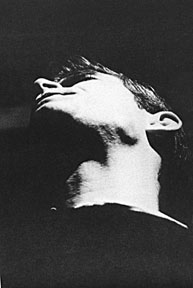
- depending on class time, try to show about 25 minutes per day.
- have new board notes and required journal entries daily.
- review what was watched the previous day, as well as anecdotes and board notes, before viewing more.
It is very important that the film be watched in segments that can be discussed before more of the film is watched. This is a method that has been extremely successful for me: it allows you to model for the students how they can be watching the film in terms of critical thinking skills, what sort of questions they can be asking in terms of exploring motivations and character development, and allows you to revisit the narrative of the film so that everyone is on the same page.
The first thing students do as they enter the room on the second day of viewing, is to copy down the new board notes. These consist of "themes", "vocabulary", information about historical events of the time the film was made, and the names of the main characters. This is important journal-writing for reflection and allows the opportunity to build upon the review and reflection process, encouraging students to add their own notations and opinions.
Then they need to write in their journal their version of the narrative up to that point. As opposed to taking away from the "entertainment" value of a film, this process actually has turned out to build keen excitement and suspense in my students as they revisit the previously viewed segment and await the next bit of the film to view.
Give students enough time for that, then lead a discussion by asking someone to describe what's happened so far. Allow others to interject plot points. As points of importance arise, it is your opportunity to stress certain themes and metaphors, saying things like, "notice that.....", or "what do you think that means...". This is also the time to connect what students remember to the themes you've written on the board. Drive the discussion with leading questions and encourage new insights to arise. Tie items in the film to the real-life historical events you've mentioned on the board.
Excitement is now built for further viewing, you're modelling how to watch a film critically, and you're striking memory chords so that the film will continue to make sense after a delay in viewing.
